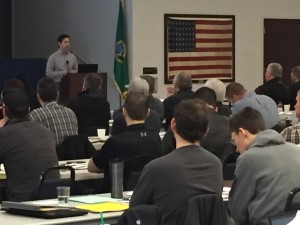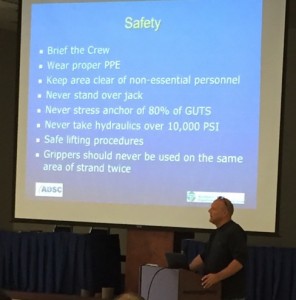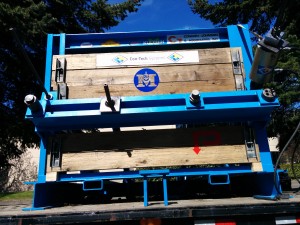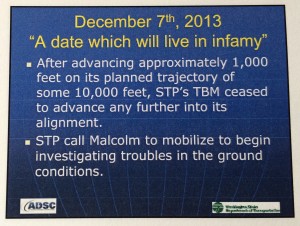On March 31st, 2016, the West Coast Chapter of the ADSC and the Washington Department of Transportation held their 13th annual Joint Training Workshop.
Again this year, Daren Konopaski, Business Manager, and the International Operating Engineers Local 302, hosted the event at their facility in Bothell, WA. The Joint Training Workshop is sponsored by the WCC/ADSC-WSDOT Task Force which has worked to develop and continuously update the WSDOT Drilled Shaft and Earth Retention Specification into a model specification for use by WSDOT, local public agencies, and private engineers. Our annual Joint Training provides an open forum to increase the understanding and use of this specification and another opportunity to improve the drilled shaft and earth retention industry.
This Joint Training Workshop attracted over 110 participants and focused on the topics of drilled shaft construction and design, non-destructive testing of drilled shafts, base grouting of drilled shafts, permanent shotcrete, and anchored earth retention. The participants included drilling contractors, consulting engineers, WSDOT personnel, and engineers from local municipalities. Through the generous support of Local 302 allowing us the use of their Bothell facility, the WCC/ADSC-WSDOT Task Force is able to keep the registration fee low enough to attract a cross section of the industry even during these difficult economic times.
The morning session started with a short presentation by Tait McCutchan, with Malcolm Drilling, on the basic methods and terminology of drilled shaft construction to get the newer participants up to speed before diving into the more detailed presentations. Anthony Mizumori, with WSDOT, discussed the use of permanent steel casing in drilled shaft design. Following up the design discussion, Brendan Harkins, of Condon-J
ohnson & Associates, Inc., gave a presentation on the planning, execution, and quality control associated with rebar and concrete placement for drilled shafts. Mark Gaines and Jim Cuthbertson, of WSDOT, jointly presented on CSL and thermal integrity testing of drilled shafts. After a short break, John Tuttle, of Sinclair Well Products, discussed the use and disposal of drilling slurry. Spark Johnston, with Condon-Johnson & Associates, Inc., then explained the basics of tieback and micro pile testing with a very informative discussion on how testing can go awry.
Ross Dennison, with Con-Tech Systems, setup a mock soldier beam wall outside the building during a rare sunny day in Seattle. During lunch, the Con-Tech crew put on an anchor testing exhibition, and John Tuttle, with Sinclair Well Products, gave a hands-on slurry testing program.
The afternoon session included a presentation by Mike Muchard, AFT, on base grouting of drilled shafts. Mike Haggerty, of Superior Gunite, then followed up with a presentation on the use of permanent shotcrete which was very timely as WSDOT is developing a permanent shotcrete specification.
In an effort to lighten the tone, the remainder of the afternoon was dedicated to case studies. Ryan Thorne, with Condon-Johnson & Associates, Inc., gave an informative presentation on a WSDOT project involving large diameter drilled shafts installed in the median of I-5 using the oscillator method. Lance Rasband, with Malcolm Drilling,
then followed with a presentation of the rescue shaft installed for the stalled TBM, Bertha, in Seattle, WA. The day ended with a case study on the slurry walls, secant piles, and tiebacks installed for the portal and two stations on the Sound Transit North Link project presented by Meredith Daniels and Ryan Thody of DBM Contractors.
With the continued cooperation between the West Coast Chapter of ADSC and the Washington Department of Transportation as exemplified by the annual Joint Training Workshop, we can improve the understanding of the design and construction of drilled shafts and earth retention systems amongst contractors, engineers, and owners.
Article submitted by Dominic Parmantier, Condon-Johson & Associates, Inc.



